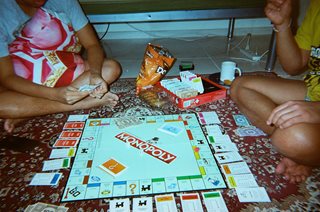Finance has a lot of abstract ideas that kids struggle with understanding. Yet, the earlier you can teach your kids financial responsibility, the better those lessons will carry into adulthood. These lessons should be taught little by little, rather than one long lesson.
Strangely enough, kids and teens struggle to pay attention in a long lecture about financial responsibility, but do you know what kids enjoy? Playing games! And there are plenty of games you can use to teach kids financial responsibility.
Why Use Games to Teach?
 The gamification of educational topics is a proven method to engage people in learning without the stress or headaches of traditional teaching styles. Not only does it encourage learning something, but it provides a way to people to immediately practice what they learned, experiment, and find what works for them.
The gamification of educational topics is a proven method to engage people in learning without the stress or headaches of traditional teaching styles. Not only does it encourage learning something, but it provides a way to people to immediately practice what they learned, experiment, and find what works for them.
Financial responsibility is a very important subject for children and teens to learn. Mistakes made early in their adult life can have a huge impact on them for years to come. They need a way to learn the principles of financial responsibility (saving money, budgeting, credit, and investing) and practice without risking their future. Games are a great way to do both learning and practicing.
Games to Teach Saving Money
 Saving money is an important idea every kid needs to learn. But just giving them a piggy bank and tell them to put spare change in it might not be enough. Games with an emphasis on saving money (or resources) in order to win can help get this idea. Here are a few games that can help teach saving money to your kids.
Saving money is an important idea every kid needs to learn. But just giving them a piggy bank and tell them to put spare change in it might not be enough. Games with an emphasis on saving money (or resources) in order to win can help get this idea. Here are a few games that can help teach saving money to your kids.
Monopoly: You’re going to see Monopoly on this list a few times, as the biggest “money” game out there. An important part of winning Monopoly is making sure you have enough money saved up to pay rent on any properties someone else owns. If you fail to pay the rent, you have to sell off your properties to pay, and if you don’t have any money left, you lose the game. Having enough cash saved up is essential to winning the game.
The Game of Life: The winner in The Game of Life is whoever has the most money at the end. Going through the game, you’ll have a few choices put in place, including what career you want, going to college, and what kind of house to buy, that impact how much money you have at the end. The more money the player can earn and save till the end, the more likely they’ll win.
Pretend Bank: You don’t need a board to have a fun and engaging game. Build a pretend bank (or credit union) in your living room, cut up some fake money (or use candy) and give the child a goal. For example, tell them if they save up $20, they win, but give temptations to spend their money. Then they earn money by doing certain tasks, which they can then save or spend on a treat.
Games that Teach Budgeting
 Kids aren’t interested in looking at spreadsheets to understand what a budget is. Plenty of adults don’t want to do that either! Lots of games with limited resources encourage kids to naturally budget their resources in order to win.
Kids aren’t interested in looking at spreadsheets to understand what a budget is. Plenty of adults don’t want to do that either! Lots of games with limited resources encourage kids to naturally budget their resources in order to win.
Pay Day: A great board game that pushes kids to budget their money, save up, and be prepared for sudden expenses. This game encourages kids to take advantage of sudden bargains on expenses they have to pay, save up for regular bills, and try to survive as long as they can.
Settlers of Catan: Maybe not the best game for young kids, but perfect for older kids and teens, Settlers of Catan is literally a game of resource management. They have to make trades, budget their resources, and make every purchase count in order to win.
The Sims: Video games can be used to naturally teach some subjects, and The Sims is great for teaching budgeting. The Sims has their players run a “simulate life” of a character they created. That character goes to work, pay bills, eats, sleeps, gets married, has kids and even dies. Players have to manage their character’s budget while trying to fulfill all of their needs, including food, relationships, and even living in someplace pretty and clean. Not only do they have to budget money, they have to budget everything about their character’s life.
Games that Teach Lending and Credit
 One of the hardest subjects to teach kids about, lending and credit are pretty obscure concepts. But don’t worry, there are some games to help teach and practice lending and credit.
One of the hardest subjects to teach kids about, lending and credit are pretty obscure concepts. But don’t worry, there are some games to help teach and practice lending and credit.
Animal Crossing: This popular Nintendo video game is a life simulator, where players manage their character’s life, home and island. In order to play, you need to purchase a home, and to buy that home, your character takes out a loan. Then, they proceed to make money to make monthly payments to pay off that loan, while doing other fun activities. Players can also take out extra loans later to expand on their home, having to make the decision to do so or save up.
Shady Sam: This simple browser game lets players do the math of loans and see the total overall costs, with interest rates, monthly payments, and term lengths. The player acts as the lender and is trying to make themselves as much money as possible, out of three loan options. Not only does it teach the basics of lending, it encourages kids to avoid sketchy lenders who are trying to take advantage of them.
Monopoly: A popular home rule to Monopoly brings in loans and credit to the game. One player acts as the bank and can give out loans to players who request it. They can only have one loan at a time, and everytime they go around, they have to make a regular payment, plus interest. Failure to pay the loan leads to the bank taking control of their properties until the loan is paid off. Failing that, the player is out of the game.
Supplement Games with Lessons and Real Life
Playing games isn’t enough though. It provides great practice and ways to learn, but don’t rely solely on it. Encourage your kids to pursue learning about financial responsibility through other mediums too, along with real life examples. Enroll them in classes, have conversations with them, and give them real life opportunities to practice safely, along with playing games.
There are tons of online resources for teaching kids financial responsibility lessons, all you have to do is look for it. One example is Pioneer partnered with Junior Achievement of Idaho on a great budgeting activity video for kids.
One thing every child should have is their own savings account. It’s a great tool for encouraging saving money and getting them in the habit of depositing money into their accounts. Pioneer’s Super Star Youth Savings account is perfect for this!
Learn more about the Super Star Youth Savings account